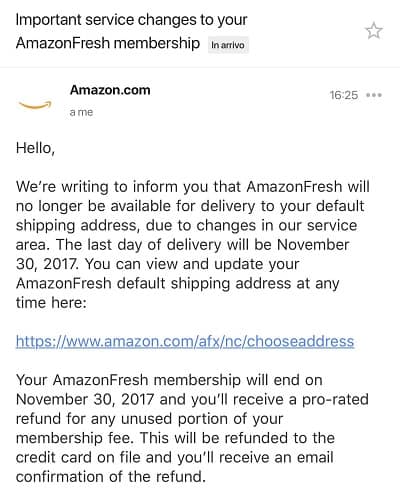Amazon.com Inc. will end its AmazonFresh grocery delivery service to ZIP codes in at least nine states at the end of November, but Amazon is not saying exactly which communities were selected.
However, consumers in parts of New Jersey, Pennsylvania, Delaware, Maryland, California, New York, Connecticut, Massachusetts, and Virginia received an email from Amazon announcing the move.
The email, which was widely shared on social media by disgruntled customers, offered few details.
“We’re writing to inform you that AmazonFresh will no longer be available for delivery to your default shipping address, due to changes in our service area,” the email says. The full text, as shared on Twitter, is below.

A copy of an email sent to soon-to-be-canceled AmazonFresh customers.
“We have made changes to our service area and discontinued delivery to select ZIP codes,” an Amazon spokeswoman says.
AmazonFresh will continue to serve consumers in at least 13 U.S. markets (Seattle, New York, Boston, Baltimore, Philadelphia, Washington D.C., Chicago, Atlanta, Dallas, Miami, Denver, Los Angeles, San Francisco) and three international cities (London, Tokyo, and Berlin).
Amazon says the move is unrelated to the retailer’s recent acquisition of Whole Foods Market Inc.. Amazon launched AmazonFresh in Seattle in 2007, but did not expand the offering beyond Seattle until 2013.
There could be several reasons for Amazon to trim back its service area for AmazonFresh, says Sucharita Mulpuru, vice president and principal analyst at Forrester Research Inc. “My guess would be that it’s some combination of Amazon wanting to combine Prime Now, Fresh and the Whole Foods operations and the high probability that those ZIP codes that are … [unprofitable] for them.”
Mulpuru says it appears that Amazon wants to to regroup and figure out if there’s a better way to make online grocery work in the affected markets.
“I suspect they have been thinking of shutting down these markets for some time but with the Whole Foods acquisition and on the heels of a great earnings release, it’s easy to let this fly under the radar and be perceived by onlookers as a reorg versus an admission of failure,” she says.
Bill Bishop, chief architect at Brick Meets Click, a consultancy for grocery retailers and the consumer packaged goods industry, says: “The problem with AmazonFresh is that they started with a concept that would never work; i.e. it wouldn’t work because there was no cost-effective supply chain in place to execute it.”
“AmazonFresh is failing,” Bishop says, “because they don’t yet get how to do fresh [food].” By contrast, he says, competitor Peapod LLC, No. 62 in the Internet Retailer 2017 Top 500, “is is excellent at it.”
Despite the pullback in its AmazonFresh business, Bishop does not think Amazon will waver in its overall commitment to selling fresh food. “This doesn’t mean Amazon is going to abandon fresh, and their purchase of Whole Foods is a solid indication that they’re not,” he says.
In a note released today, Chuck Grom, an analyst for Gordon Haskett Research Advisors, says: “While details behind Amazon’s actions are sparse, it’s hard not to view this as another confirmation that the economics behind fresh grocery delivery remain challenging and the associated issues are hard to overcome without reaching the right scale. Nonetheless, we view the latest news as a positive data point for those retailers with vast grocery exposure, more so targeting the suburban customer, in particular Costco, Wal-Mart, Target, and Sprouts Farmers Market.”
Amazon, the No. 1 in the Internet Retailer 2017 Top 500, made a splash in the grocery world earlier this year when it acquired Whole Foods for $13.7 billion. Since then, Amazon has made high-profile cuts to prices at Whole Foods stores, added products from the Whole Foods house brand to Amazon.com and started delivering some Whole Foods-branded products via Prime Now two-hour delivery.
Customers unhappy about losing their AmazonFresh service took to Twitter to express their dissatisfaction.
Is this for real or a scam? There’s talks of it being a scam? What’s going on @amazon?? #AmazonFresh pic.twitter.com/XRO1066nKe
— Nikki O (@StarfishLiving) November 3, 2017
We are very disappointed to learn that @AmazonFresh no longer services our area. This was a working professional’s dream. #AmazonFresh pic.twitter.com/PyqIzqJQlx
— Dr. Michaelyn (@Freeway_FooFoo) November 2, 2017
really @amazon !? You get us hooked on #Amazonfresh, we sign up, evangelize the hell out it for you, then you stop shipping to my address!!
advertisement— Rob Avery (@rob_avery) October 31, 2017
Favorite#amazonfresh Pretty unhappy Fresh service dropped in my area. I sold my car cause I didn’t have to grocery shop. Now I have to buy a car!!!
— xkrebstarx (@xkrebstarx) November 1, 2017
advertisement
